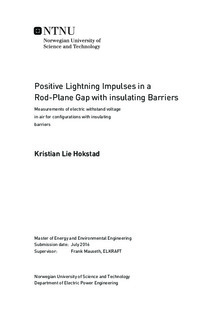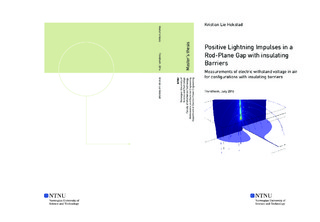| dc.description.abstract | Today's design and manufacturing of high voltage equipment focuses increasingly on a shift away from SF6as a quenching and isolation medium. SF6 is has a detrimental effect on the atmosphere's greenhouse potential. Bans or regulations regarding SF6 may well be imposed on the industry in the future. In order to replace SF6 with air as insulation, more research is needed to achieve compact and efficient designs.
The goal of this master thesis has been to investigate the effect of barriers on the withstand voltage in rod-plane gaps, with atmospheric air, subjected to positive high voltage impulses. The high voltage electrode was a rod with a spherical tip and a diameter of 7 mm. The barriers used as insulation were made out of Lexan polycarbonate plates and measured 1 mm times 600 mm times 600 mm. The 50%breakdown voltage, the standard deviation and the withstand voltage have been determined using the up- and down-method. The barriers were tested in several configurations, changing both the horizontal and vertical placement of the barrier in the rod-plane gap. In addition to physical experiments, these configurations have been investigated in terms of electric background eld calculations in COMSOL,as well as streamer inception voltage calculations in MATLAB.
The results show an increase in the withstand voltage of up to 28% for the configuration with the largest barrier protrusion. The optimal barrier position has been found to be close to the high voltage rod. However, a relative decrease in the withstand voltage is observed when the rod is touching the barrier. This can be explained by a strong tangential eld allowing the streamer to propagate along the surface of the barrier. For a small barrier, protruding 0 mm from the tip of the rod, the withstand voltage is lower than that of a barrier-less rod plane gap when the barrier touches the rod. A sharp increase of above 10% in the withstand voltage is shown in a barrier with a 0 mm overlap, by simply moving the barrier10 mm closer to the high voltage rod. This can to some degree be explained by applying electric potential to the barriers in the background eld distributions.It has been shown that the withstand voltage can be predicted to some extent with a very simple formula for the congurations with the largest barrier protrusions.
A method of predicting withstand voltage based on streamer inception calculation in several steps, with electric eld distribution calculations has been suggested. | |

